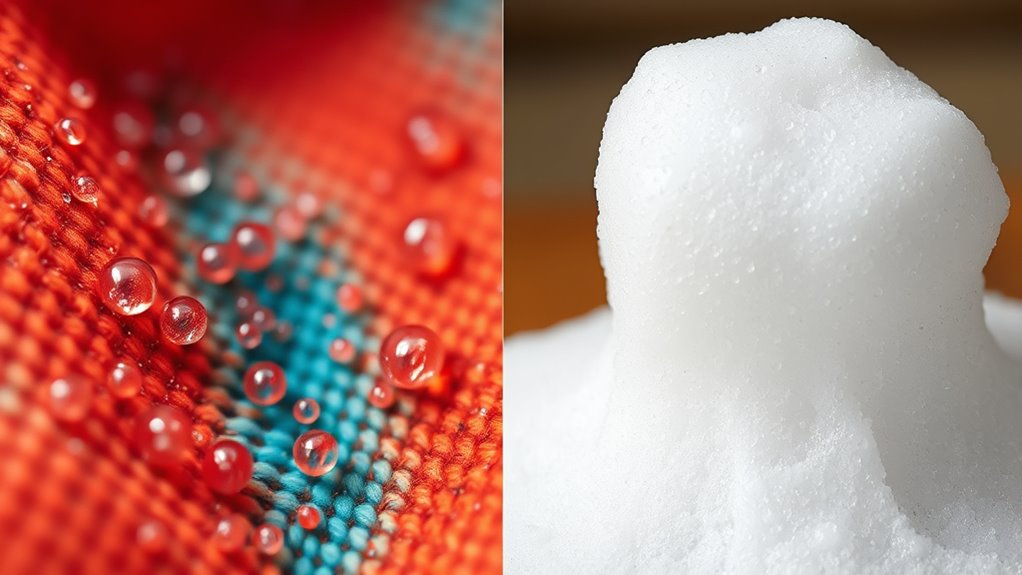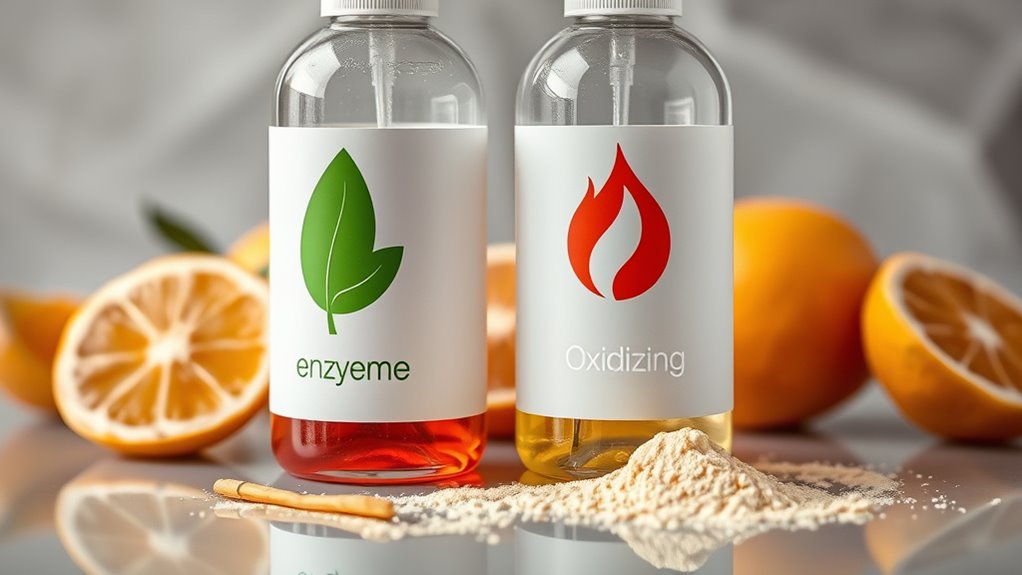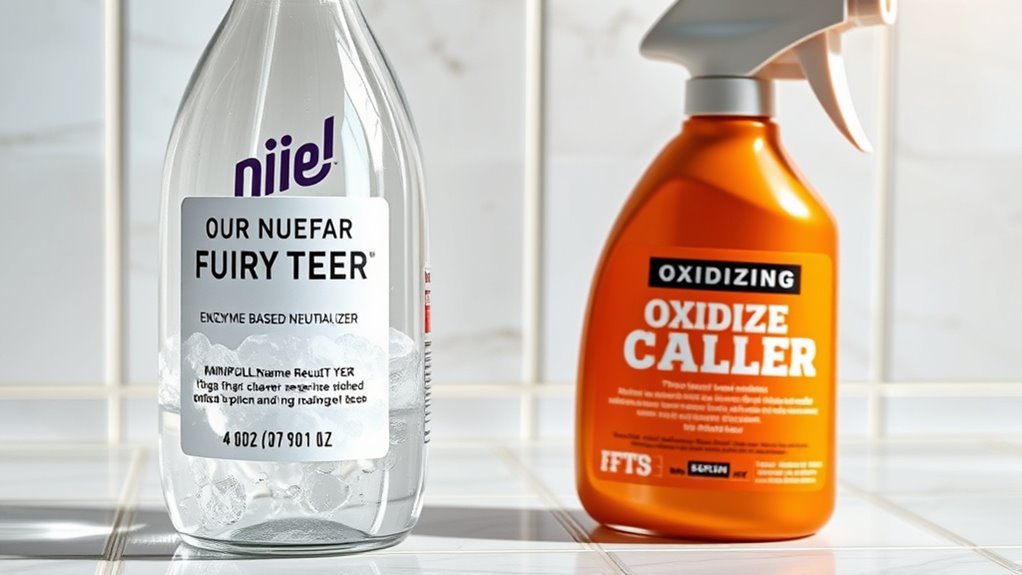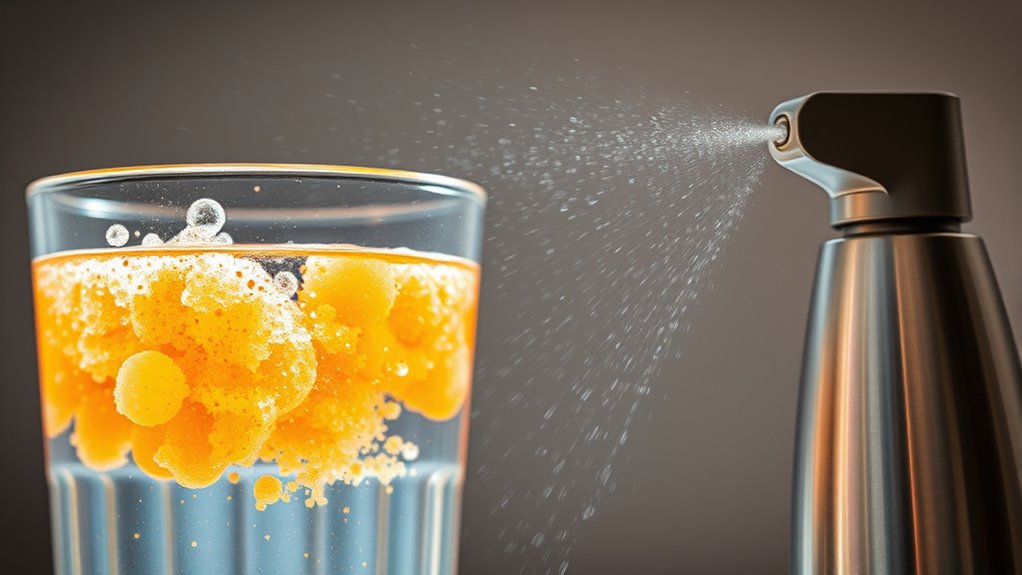Enzyme cleaners target organic odors by breaking down odor-causing molecules into harmless substances, making them gentle and safe for household use. Oxidizing cleaners quickly eliminate odors through chemical reactions that change molecules into water, CO₂, or other safe compounds, often with stronger chemicals. Choosing between them depends on your needs—enzymes work well on organic smells over time, while oxidizers provide rapid results. To learn which option suits your situation best, keep exploring further.
Key Takeaways
- Enzymatic cleaners target organic odor molecules by breaking them down naturally, making them ideal for biological and organic stains.
- Oxidizing cleaners chemically react with odor molecules, transforming them into harmless substances like water and carbon dioxide for quick odor removal.
- Enzymes are safer for household use, posing minimal risks, while oxidizers contain strong chemicals that may cause skin irritation or material damage.
- Enzymatic solutions require moisture and longer contact time, whereas oxidizers work rapidly, especially on stubborn or chemical odors.
- Choose enzymatic cleaners for organic and biological odors, and oxidizers for persistent chemical or smoke odors needing quick neutralization.
How Enzyme Cleaners Work to Eliminate Odors

Enzyme cleaners work by targeting the molecules that cause odors at their source. When you apply an enzyme cleaner, the enzymes latch onto the odor-causing particles, breaking them down into smaller, less volatile compounds. This process effectively neutralizes the smell rather than just masking it. You’ll notice that enzyme cleaners are especially good at tackling organic stains and odors from things like pet accidents, food spills, or biological messes. As the enzymes work, they accelerate the natural decomposition process, transforming the offending molecules into harmless substances. This targeted approach ensures that odors are eliminated at their root, providing a deep clean that leaves your surfaces smelling fresh. Color accuracy in the cleaning process can enhance the visibility of residues and stains, making it easier to see where the application is most needed. With enzyme cleaners, you’re addressing the problem directly, rather than just covering it up.
The Chemical Process Behind Oxidizing Cleaners

Oxidizing cleaners neutralize odors through a chemical reaction that transforms odor-causing molecules into harmless substances. When you apply these cleaners, they release reactive agents like hydrogen peroxide or sodium hypochlorite. These agents target the molecules responsible for bad smells, breaking their chemical bonds through oxidation. This process changes their structure, rendering them odorless and often turning them into water, carbon dioxide, or other non-toxic compounds. Unlike enzymes, which break down organic molecules, oxidizing cleaners rely on powerful chemical reactions to neutralize odors quickly. You’ll notice that this method is effective on a wide range of odors, including organic stains and persistent smells. The key is the chemical transformation, which eliminates odors at a molecular level, providing a deep and lasting clean.
Comparing Effectiveness and Safety of Both Methods

While both enzymatic and oxidizing cleaners effectively neutralize odors, their safety profiles and suitability vary depending on the situation. Enzymatic cleaners are generally safer for household use, as they break down organic matter without releasing harmful chemicals, making them ideal for delicate surfaces and areas with children or pets. Oxidizing cleaners, on the other hand, contain strong chemicals like bleach or hydrogen peroxide that can be effective but pose safety risks if misused, such as skin irritation or respiratory issues. While oxidizers can quickly eliminate tough odors, they may damage certain materials or cause discoloration. Enzymatic cleaners tend to be gentler but may require longer contact times. Choosing the right method depends on balancing effectiveness with safety considerations for your specific environment. Additionally, understanding the fabric decorating markers and their appropriate use can help prevent accidental damage when cleaning or deodorizing fabrics.
Ideal Uses and Limitations of Enzyme vs. Oxidizing Products

Choosing the right odor neutralizer depends on your specific needs and the environment you’re working with. Enzyme cleaners excel at breaking down organic odors like pet messes, stains, and food spills, but they require moisture and time to work effectively. Oxidizing products are better for strong, persistent odors such as smoke or chemical smells, as they chemically alter odor molecules quickly. However, oxidizers may damage delicate surfaces or fabrics. Use enzymes in damp areas for ongoing odor control, but avoid them in direct sunlight or high heat. Oxidizers are ideal for rapid odor removal on non-sensitive surfaces, yet they can be harsh and require careful handling. Here’s a quick comparison:
| Use Case | Enzyme Cleaner | Oxidizing Cleaner |
|---|---|---|
| Organic odors | Excellent | Limited |
| Strong chemical odors | Limited | Best |
| Sensitive surfaces | Safe | Caution |
Additionally, understanding the celebrity lifestyle associated with various cleaning products can offer insights into how celebrities maintain their homes, which often includes choosing specific odor control methods.
Tips for Choosing the Right Odor Neutralization Solution

Selecting the right odor neutralization solution starts with understanding your specific odor problem and the surfaces involved. Identify whether the odor is caused by organic matter, bacteria, or chemical residues. This helps determine whether enzymes or oxidizers are more effective. Consider the material you’re treating—porous surfaces like carpets or upholstery may require different products than non-porous surfaces like tile or metal. Always check product labels for compatibility and instructions. For persistent or deep-seated odors, enzyme cleaners can break down organic sources, while oxidizers can quickly eliminate strong chemical smells. Test a small area first to avoid damage or discoloration. By understanding your odor source and surface type, you can choose a solution that effectively neutralizes odors without causing harm. Knowing the role of enzymes and oxidizers can help you select the most suitable product for your needs.
Frequently Asked Questions
Can Enzyme and Oxidizing Cleaners Be Used Together Safely?
You might wonder if enzyme and oxidizing cleaners can be used together safely. Generally, it’s not recommended because they can react negatively, reducing effectiveness or creating harmful compounds. Enzyme cleaners break down organic matter at a biological level, while oxidizers like bleach release reactive oxygen species. Using them together could neutralize their benefits or cause chemical reactions. Always follow manufacturer instructions and avoid mixing cleaners to guarantee safety and ideal results.
How Long Do Enzyme Cleaners Typically Take to Eliminate Odors?
You wonder how long enzyme cleaners take to get rid of odors. Typically, you should allow them to sit for 15 minutes to several hours, depending on the strength of the odor and the surface. For stubborn smells, it’s best to leave the enzyme cleaner overnight. Follow the manufacturer’s instructions for maximum results, and guarantee the area stays moist to let the enzymes do their job effectively.
Are There Environmental Impacts Associated With Oxidizing Cleaners?
You might wonder about the environmental impacts of oxidizing cleaners. These products can release chemicals like chlorine or peroxide that may harm aquatic life and contribute to pollution if not disposed of properly. They often contain harsh substances that can degrade water quality and affect ecosystems. To minimize your impact, always follow disposal instructions and consider eco-friendly alternatives when possible.
Do Enzyme Cleaners Work on All Types of Organic Odors?
You wonder if enzyme cleaners work on all organic odors. They’re highly effective for many common smells like pet urine, food spills, and organic stains. However, they might not eliminate strong or stubborn odors like smoke or mold completely. For best results, use enzyme cleaners on fresh or light odors, and consider combining them with other cleaning methods for tougher smells. Always follow the manufacturer’s instructions for maximum effectiveness.
What Are the Storage Requirements for Enzyme and Oxidizing Odor Removers?
Did you know improper storage can reduce cleaning product effectiveness by up to 50%? For enzyme and oxidizing odor removers, store them in a cool, dry place away from direct sunlight and heat sources. Keep containers tightly sealed to prevent degradation. Avoid freezing or storing near incompatible chemicals. Proper storage guarantees their active ingredients stay potent, so your odors get neutralized effectively when you need them most.
Conclusion
Just like Hercules faced his labors, choosing the right odor neutralizer depends on understanding your needs. Enzyme cleaners are your gentle warriors against organic smells, while oxidizing cleaners act like lightning, breaking down stubborn odors. When you pick wisely, you become the hero of your space. Remember, whether you summon the power of enzymes or the might of oxidation, your fresh, clean environment awaits—ready for you to conquer the day.








